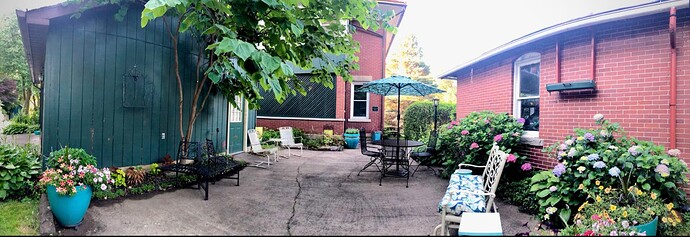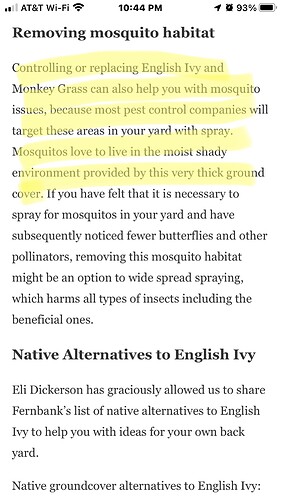This forum thrives on nonsense. I spit water out on that one. Thanks for the giggle.
There’s an article in today’s New York Times, Wirecutter section, on mosquito control. They like Thermacell products.
In2Care traps are the only thing that have worked for us. We’re in the tropics in a rainforest. They break the mosquito cycle by killing the larvae. not repel mosquitoes.
I tried to find In2Care. Unfortunately, in the US, only licensed pest control companies can get it and set it up. The nearest company that can do that for us is 99 miles away (a 2 hour drive).  I’m pretty sure the pest control company won’t come so far as our area.
I’m pretty sure the pest control company won’t come so far as our area.
What is the second best, do you reckon?
Have any of you tried the Thermacell products? What did you think of the product?
Our AirBnB listing has a lovely, private patio in back of the house, it’s enclosed by garages on two sides with a lovely redbud tree growing beside one garage which arches over the patio and provides shade during the afternoon and evening. The house and a hedge partially screen the third side, and there’s a steep hillside on the fourth side.
The hillside doesn’t belong to us. It’s overgrown with ivy, which provides a great environment for the skeeters so, once the skeeter season gets going, the patio becomes unusable, especially in the evening. I’m desperate for a solution.
I already do everything I can to eliminate breeding sites on the property. I can’t do anything about the ivy covered hillside. Any suggestions?
A panoramic photo of the patio. The ivy covered hillside is behind me.
I haven’t used it. It does seem a little expensive, and I don’t recall if your space is a shared space. If not, the guests would need to be in control of the product and might not be good financial stewards of this resource. If you’re there, you manage its use, but it’s one more thing for you to do.
From what I’ve read the key is relentlessly finding standing water and getting rid of it. We now go around with a turkey baster to get the water out of the bottoms of plant containers. We’ve made sure our gutters are pitched not to hold water.
We also have several citronella plants that grew to the sizes of bushes, which smelled great, maybe helped. We also placed fans on our pergola as we read the insects don’t like the breeze. We’re replacing our soffit lights with true bug lights (not just yellow lights), which don’t repel insects but are said not to attract them. Last year, through our hard work or sheer luck we had almost no mosquitoes.
I’m wondering why you think the ivy-covered hillside is a breeding ground unless you know there’s standing water there.
Another possibility is to encourage or attract predators of the mosquitoes. At another home we put up a bat house, but the bats never came. My primary host has a place in Brazil and she’s reluctant to put up a bat house lest the bats invade her attic. [It happened to her before. You need to well seal all the nickel-thick crevices to your home, which isn’t easy.]. Maybe there are other natural predators you could attract?
You could spray for mosquitoes, but I’ve read that that’s not worth it. Plus it creates other issues for pets, any food/herbs you might be growing, and just overall your health and your environment. With such a sanctuary you’ve created, natural remedies seem most consistent.
@PitonView 's suggestion of In2Care traps is worth taking up. Where to buy? - In2Care suggests you need to hire a pest management company to install them.
If after you’ve done all the natural things you can do, and still have mosquitoes, the Thermacell system might be worth trying out. Find out what the maintenance cost is and that you can get those supplies ( I read a few complaints on Amazon about that).
I have friends that deliberately built ledges for barn swallows after seeing them nesting in the beams of timbered open shelters at Mendenhall Glacier, where the Forest Service uses them for organic skeeter control.
Once a group starts nesting in an area their flock will return every spring. They love a group of ledges sheltered from wind and rain, where predators can’t reach. My friends built their nest brackets in the fall, so they were available during spring migration.
Edit: You have to think about which birds you encourage with nest boxes or other habitat. I can tell you from experience that you do NOT want a bunch of baby jaybirds, crows, or ravens screaming you awake at dawn as an adult approaches the nest. With them, you need to be observant and take the nest apart as they start to build it so they will go somewhere else.
Providing places for insect eating birds to nest and/or forage is almost always beneficial. That’s what we should be doing instead of poisoning everything.
Can’t disagree with that! I hate poisoning Mother Nature and only use chemicals on poison ivy.
That said, we have bats in our area. Unfortunately, they have gotten in the AirBnB house three times…twice while guests were occupying it. Luckily, each time the guests were totally cool about it. So I’d rather find another natural predator to go after them. I’ll have to look into barn swallows. I don’t know if it would work here, because we are in an semi-urban setting (in town but in an old residential neighborhood with lots of green area). Unfortunately, we have a lot of hawks here.
And yes, ivy does present a problem when it comes to mosquitos. The soil underneath the ivy stays damp and mosquitos breed there.
That Thermacell device uses allethrin as the repellant. It’s a synthetic version of pyrethrin, a substance found in chrysanthemums. So you’d think, “Oh, it’s natural, no problem”.
Well, it is fatal to fish, crustaceans, and some species of birds.
No thanks.
Oh dear! I did not know that. Well, I guess I won’t be buying that!
I try eliminating all areas that hold water, planting citronella plants (they are annuals here), and put fans on the patio so the breeze will discourage them. Plus I have several types of bug repellent available to the guests, plus citronella candles. It doesn’t seem to have made much of than impact; they still make sitting on the patio unpleasant at times.
It’s hot and humid here and we average 42 inches of rain a year, spread fairly evenly throughout the year. Keeping the skeeter population down, once it heats up, is a challenge.
I don’ t know if you ever read something I had posted before about how scientists 20 years ago had found that setting out bowls of fermented fruit juice (that and fermented flower juice is the main diet of all but the breeding females, who go for blood), with boric acid in it, knocked out the local mozzie population where they were running these experiments somewhere in Africa, by 90% within a week!
It’s worth a try. Leave some fruit juice out for a couple days so it ferments, then put some boric acid in it and set some bowls of it around near your patio.
Thank you Muddy, I will give that a try!
Let us know if it works, please!
It won’t be skeeter  season here for a while yet. Thank goodness!
season here for a while yet. Thank goodness!
Doing a little research on the fermented fruit juice and boric acid, some articles mention it also attracts and kills bees.
@Keugenia - have you contacted the In2Care people to find out options since the nearest supplier is so far away? it might be worth an email.
Oh, bummer. I wouldn’t want to kill the bees. Thanks for that. I was just thinking in terms of it not being toxic to pets (nor are dogs or cats particularly attracted to sweet things like fruit juice, in my experience with my own pets) who might run across it.
I definitely wouldn’t want to hurt the bees! They are struggling enough these days!
Maybe I will email the In2Care people.
It seems like, when it comes to controlling pests and vermin, unintended consequences almost always ensue. ![]()
I looked into trying to attract swallows. Unfortunately, our landscape is exactly not what they are looking for, i.e., we are in an urban area with lots of trees, little open area, and little running water.
Bees are big, mosquitoes are tiny… some sort of mesh?
Be very careful about mesh. Any mesh that you can poke your finger through is extremely dangerous and often deadly for bats.


